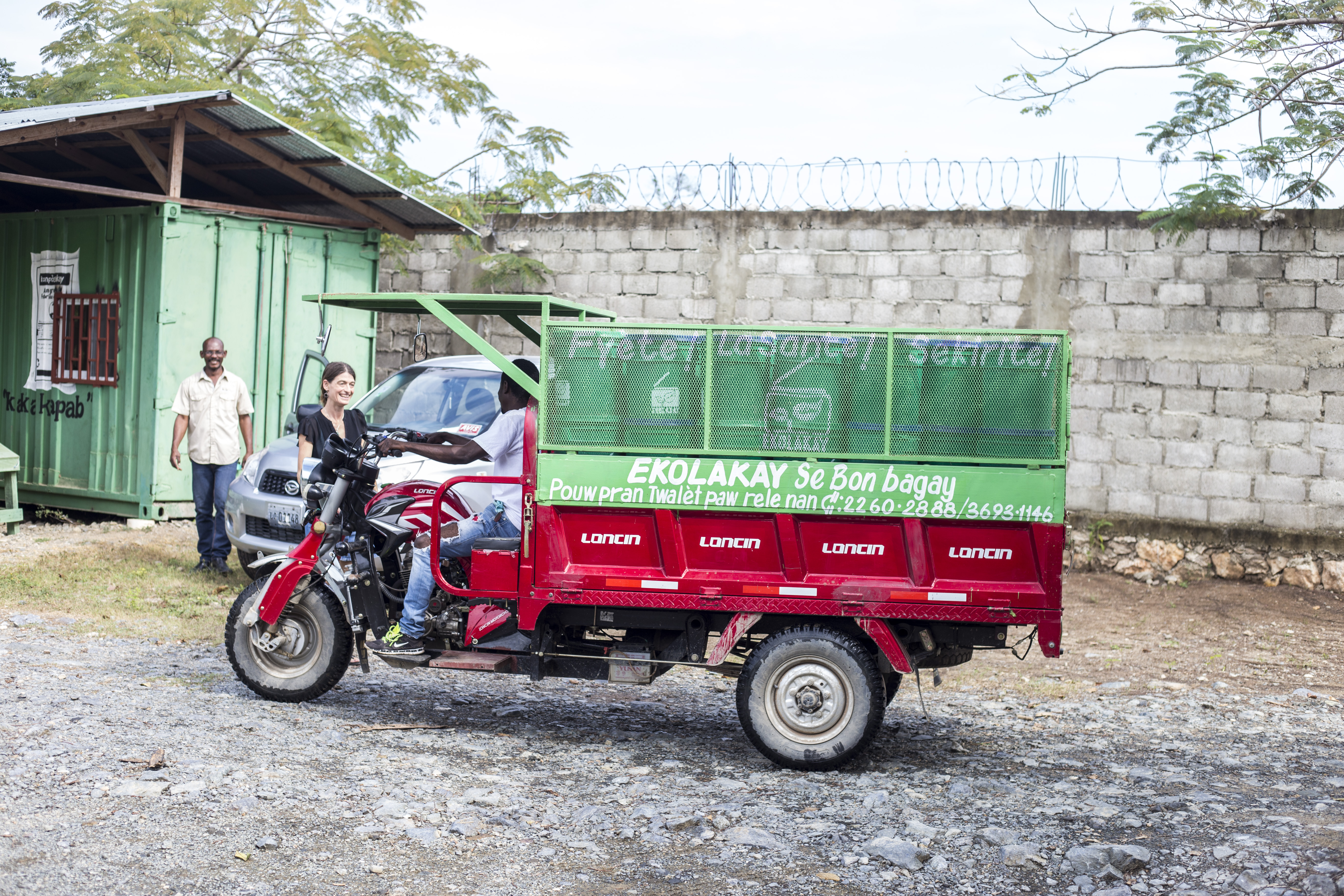Editors’ note: Support for this feature was provided by the European Journalism Centre via its Innovation in Development Reporting Grant Programme, as part of Chelsea Wald’s reporting project #WasteNot, which covers solutions for recovering nutrients from urban organic waste for agriculture. You can find more #WasteNot reports on Twitter @chelseawald, and on Facebook @chelseawaldwriter, and share your favourite waste-to-food initiatives with the hashtag #WasteNot.
This story is published in Creole: “Vil ki pa gen kanalizasyon pou matyè fekal.”
The late November rain fell hard overnight, roaring like a jet engine on the metal roofs of Cap-Haïtien, a northern port city in Haiti. By morning, many streets, including in the poor, densely populated community of Fort Saint Michel near the city’s small airport, had become stagnant canals.
Plastic bottles, tin cans, and rotting bananas floated on these urban waterways. Children in bare feet waded to school in their uniforms, holding their shoes.
Meanwhile, a green-and-red, three-wheeled motorcycle wended its way along a road, driven by two men in neon-green uniforms with thick rubber gloves. Despite the flooding, they were making their usual rounds. The men picked up full green buckets left by the side of the road – sometimes in several inches of water – loaded them onto the flatbed in back, and replaced them with empty ones.
In the full green buckets? Poo.
That urban excrement was about to follow a path to resurrection as compost, clean of pathogens, ready for use by nearby farmers. And in a place where cholera is only the latest high-profile problem caused by widespread faecal contamination, these poo pickups have become an experiment not only in sanitation, but also in closing the broken nutrient loop that once connected people to the land. If embraced by everyone from toilet-users to policy-makers, it could be scaled “up, out, and deep” to help Haiti and other places in need of basic sanitation, says Tim Daw of the Stockholm Resilience Centre (which publishes Rethink), helping create a needed “mind shift away from large-scale engineered solutions to recognise more adaptive ones” that work in places that cannot afford utilities typical elsewhere.

Despite flooded streets, an EkoLakay worker picks up full buckets to take for composting. Photo: Caleb Alcénat/Labelimage for Project #WasteNot (CC BY-NC-ND 4.0).
Green waste
The team on the motorcycle truck making its rounds that November morning worked for EkoLakay, the business arm of the non-profit SOIL (Sustainable Organic Integrated Livelihoods), which was founded by two Americans and a group of Haitian community leaders in 2006. SOIL is reinventing the 19th-century European practice of “night soil” for 21st-century Haiti, and rebranding it as “container-based sanitation”.
EkoLakay customers – who tend to have limited access to electricity and water grids as well as sanitation – rent toilets with buckets in them; then, on the outskirts of town, SOIL turns the contents of those buckets into a rich and safe compost ideal for Haiti’s depleted soils. After more than a decade of trial and error, the programme now serves about 1,000 households. That’s still about 1% of Cap-Haïtien’s population, but SOIL aims to soon expand its services to 8,000 households.
Excrement-filled buckets are a far cry from a conventional sewer system, but for now, SOIL is the only game in town, a tenacious survivor of Haiti’s harsh conditions, which include deep poverty, political instability, and severe weather. The organisation’s journey reflects some of the principles of “applied resilience thinking”, an approach to development that draws on the science of the complex interactions between people and nature in order to build systems that are better able to cope with disturbances, surprises, and uncertainty, says Daw.
One applied resilience strategy is to involve many levels of actors – in SOIL’s case, from intergovernmental agencies to potential customers. Another is “adaptive management”: Instead of implementing a potentially flawed idea at a large scale from the beginning, SOIL has constantly adjusted based on new knowledge as it has grown. While it takes more time, it often leads to more sustainable outcomes, and could ultimately allow SOIL to achieve its goal of fundamentally transforming the relationship between farmland, food, and human waste, in Haiti and elsewhere.
SOIL has constantly adjusted based on new knowledge as it has grown.
“A lot of NGOs want to get in and get out and produce the numbers and move on to the next project,” says Elizabeth Campa, senior health and policy advisor at Zanmi Lasante, the Haitian sister organisation of non-profit Partners In Health. But SOIL has worked slowly, cultivating relationships. Its business model enables Haitians to take sanitation into their own hands. “At the end of the day they should have the power.”
SOIL’s model offers hope not only for Haiti, but also for the 4.5 billion people around the world with unsafe sanitation, in particular those in rapidly urbanising areas, says Sasha Kramer, SOIL’s co-founder and executive director. In those densely populated, largely informal communities, sewers and treatment plants can be prohibitively expensive to build and maintain. Affordable on-site solutions, such as pit latrines and septic tanks, fill up too quickly, and require sludge to be sucked out and treated similarly to sewage sludge.
“I would like to see container-based sanitation be up there with ‘on-site’ and ‘sewered’ as something that’s considered for urban areas all over the world,” she says.
Back to Nature
Kramer saw an opportunity in Haiti’s lack of sewers – an unattainably expensive amenity for one of the poorest countries in the Americas. Composting human waste, she thought, “was a really nice way to use ecological systems to address a whole suite of basic human rights issues”.
SOIL’s process of turning poo to compost could reduce cases of typhoid, diarrhoea, and childhood stunting, among other health risks. But it could also close the broken nutrient cycle, recycling elements from food like nitrogen and phosphorus, as well as organic matter, back into Haiti’s heavily depleted soils, increasing national food production. With a PhD in ecology from Stanford University, Kramer had a lens to see this larger picture. The U.S. native moved to Haiti in 2006; she now lives there with her husband and young son.
But things didn’t go as expected. Working with their colleagues in Haiti, Chantal Augustin, Josaphat Augustin, and Baudelaire Malgoire, and following best practices from South Africa, Kramer and engineer Sarah Brownell (who left SOIL in 2010 and is now at Rochester Institute of Technology), built public toilets perched on big composting vaults in rural areas. Despite initial enthusiasm, however, the communities didn’t maintain the toilets. “In the end people who are struggling just to survive just don’t have time to clean up someone else’s waste,” Kramer says. Later, Kramer and Brownell also found that the compost created in the vaults still contained some pathogens, which was potentially dangerous and unacceptable for the project’s standards.
Then, in January 2010, a 7.0-magnitude earthquake hit, and nothing in Haiti would ever be the same – including SOIL. Desperate to help, Kramer and four colleagues took off for Port-au-Prince, which had been practically levelled in parts.
Giant tent encampments had been built virtually overnight, and they were full of displaced people who needed toilets. With funding from Oxfam GB, Kramer put a new idea into action: Instead of following the model of leaving the waste in the toilets to break down on its own, as many emergency responders in Port-au-Prince were still doing, Kramer’s team stashed 15-gallon buckets inside them and organised weekly collection.
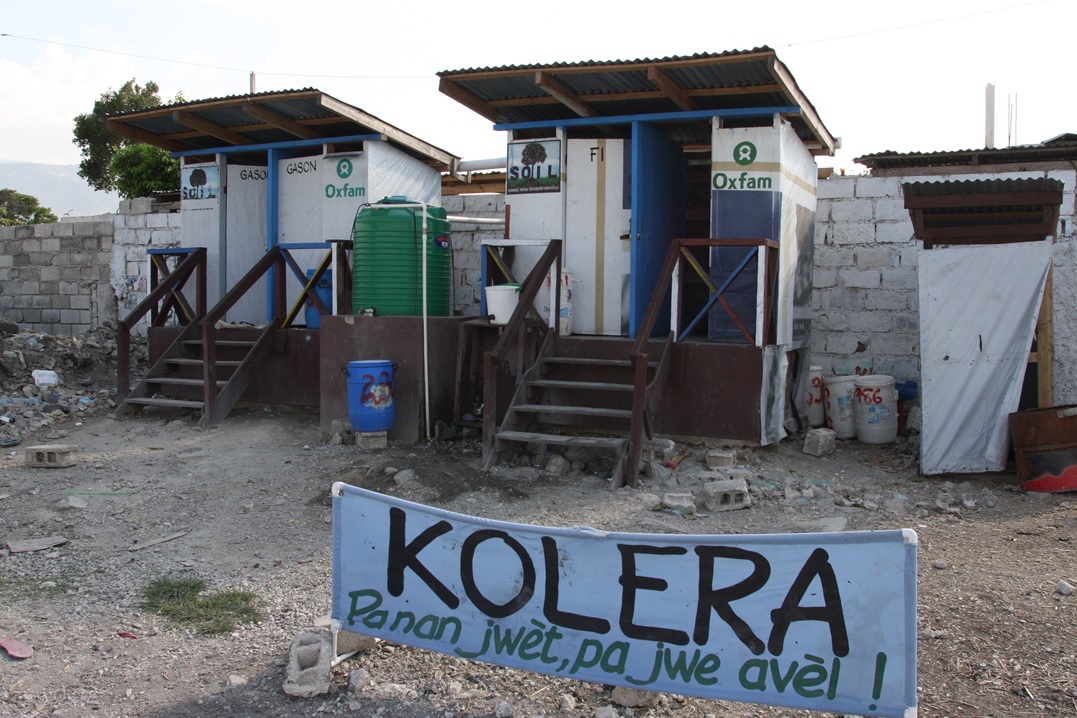
SOIL’s composting toilets in Port-au-Prince after the earthquake, one of 15 sites as part of a pilot project on container-based sanitation solutions for emergency settings. Following a cholera epidemic, the sign reads “CHOLERA – It’s not a game, don’t play with it!” Photo courtesy of SOIL, all rights reserved.
Each of SOIL’s 200 toilets was used by about 100 people per day. The organisation bought a piece of land and, by June 2010, set up a composting site. At the time it was the only functioning human waste treatment site in all of Haiti.
This fact took on new importance in October of that year, when cholera began spreading in the country for the first time in modern memory. SOIL’s composting system would kill the cholera bacterium, but Kramer realised that they would have to toughen up on safety. Before cholera, “we were, like, poop is cool. Poop is amazing,” she says. “We had to refine our message to say, poop is really dangerous. And the things you can do with it are really amazing.”
Bucket brigade
Kramer ran the emergency response programme in Port-au-Prince for five years (a small operation continues there today). At the same time, in early 2011, she decided it was time to bring the lessons from Port-au-Prince back to SOIL’s home of Cap-Haïtien, to see if container-based toilets could work in non-emergency situations. This time, the service would be for households; people would be more willing to pay for and clean a private toilet in their own home.
For inspiration, Kramer could look to few models. In some rapidly industrialising 19th-century European and North American towns, night-soil collectors would regularly travel through the streets after dark to collect bucket toilets from homes; the waste would ultimately fertilise farmland. After sewers replaced these systems, people perceived night-soil buckets as antiquated and shunned them. That included sanitation experts, who encouraged developing countries to follow in the industrialised world’s footsteps and embrace a mix of on-site sanitation (pit latrines and septic tanks) and sewers.
Undeterred, Kramer partnered with a team from Stanford University to design bucket-based toilets in consultation with residents of a poor community known for toilets that overhung the river, as well as for the use of flung plastic bags called “flying toilets”. In two papers, the Stanford team reported that customers loved the pilot container-based sanitation service, and that it “dramatically” reduced free-floating faeces.
See all references
By the end of the 2011-2012 pilot, 71% of the 118 households that participated chose to continue with SOIL as paying customers. Seven years later, the operation in Cap-Haïtien has expanded to 58 mostly Haitian staff members (plus 19 in Port-au-Prince), serves more than 1,000 households, and continues to grow by about 40 households every month.
From poo to product
After the collection team picks up the full buckets and delivers them to depots, a flatbed truck then ferries the waste to the composting site some 12 km outside the city. There, teams of six or so workers empty the buckets into bins about the size of a horse stall. They wear bright green jumpsuits, face masks, and thick rubber gloves, and work silently, following protocol, in order to maintain their focus while handling the potentially hazardous material.
For the most part, the contents of the buckets appear less like manure and more like a fluffy, odourless mulch. That’s because the customers cover their poo with peanut shells and bagasse, the fibrous leftovers from processed sugarcane. SOIL toilets don’t collect urine, which is simply diverted away from the bucket with a funnel at the front of the toilet; transporting all that heavy liquid would be far too costly, and the pathogens are in the faeces.
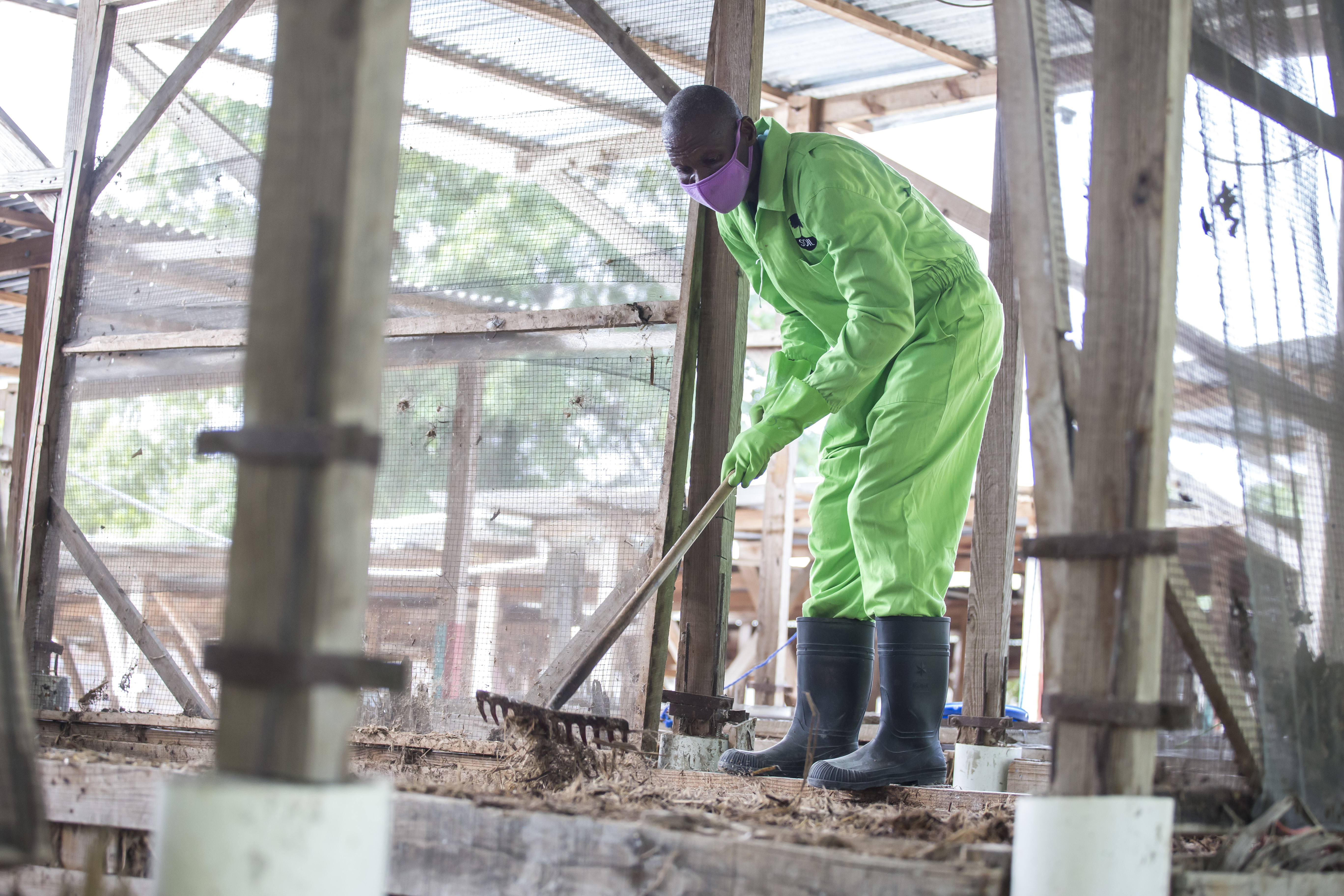
Wearing protective gear, a worker at the composting facility rakes cover material over a newly filled compost bin. Photo: Caleb Alcénat/Labelimage for Project #WasteNot (CC BY-NC-ND 4.0).
The SOIL composting process is low tech, consuming as little fuel and water as possible, but requiring hard physical labour from the staff, often in intense heat. Thanks to microbes that naturally colonise the piles, the mixture in the bins reaches temperatures as high as 70°C, enough to kill the pathogens in them, such as E. coli and a parasitic worm called Ascaris, which can cause symptoms from shortness of breath to diarrhoea and contribute to malnutrition.
See all references
After about 10 weeks in the bins, the workers unload them onto concrete slabs, where they turn the compost every two months for about six months. The over 40 metric tons of waste that comes in per month breaks down to at least 9 metric tons of dark brown compost.
That may not be much relative to all the waste in Cap-Haïtien, but it still beats the competition. Recently, in preparation for making a US$125-million (£96-million) investment in water and sanitation in Haiti, the Inter-American Development Bank (IDB) undertook a study to map the pathways of human waste in Cap-Haïtien. One way or another, the study found, 99% of human waste ends up contaminating the environment.
Open defecation accounts for 11% of that. A road by a downtown hospital is informally designated as “an open public toilet,” says Adrien Joseph Emmanuel Demes, the Haiti programme director for Konbit Sante Health Partnership. The hospital has toilets only for patients and doctors, and there are no proper public toilets in the area, so hospital visitors, street-food vendors, and nearby residents who don’t have toilets at home make do with squatting as discreetly as they can along this street. Even in areas where there are public toilets, the facilities can be disgusting and dangerous, especially at night.
Another 44% of the waste, according to the IDB study, is “not contained”. Although many people in Haiti have septic tanks and pit latrines, there’s no guarantee that these work as they should. And, if they leak, the consequences can be dire. “The groundwater is, even on a non-rainy day, maybe 3 ft [about 1 m] maximum below the surface. You’re just pooping into the groundwater,” Kramer says.
From the flow, 42% of the waste is “not delivered to treatment”. Even if the septic tanks and pit latrines work, they fill up. If people can afford the one-time fee – which can cost an average of about £40 (4,000 Haitian gourdes) depending on the techniques and the volume – they hire unregulated and highly stigmatised workers known as bayakou to empty them under the dark of night. With no legal place to put the contents, the bayakou dump them wherever they can, often into waterways. (Mechanical emptying is also available for higher prices.)
Finally, 2% is delivered to treatment, but “not treated”. In fact, there are only two major waste treatment plants in all of Haiti, both in the capital Port-au-Prince, of which only one is currently functional, and only in part. In Cap-Haïtien the sanitation authority built a rudimentary treatment site – known as a waste stabilisation pond – for septic-tank waste a few years ago, but today it’s no longer in use: the gate is locked and recently one of the cement pools appeared to be filled with dumped oil. The main septic-tank emptying company now spreads the waste in an unsecured field where people walk and animals graze.
The scant 1% of human waste that, according to the study, ends up “treated”? That’s all SOIL, and it’s something to be proud of, says Joasil “Tidou” Lucny, the tall, eloquent composting supervisor who serves as an unofficial spokesperson for the staff at the plant. “You can consider everyone on the staff as a hero because what we’re doing is very important” not just for Cap-Haïtien, but as a model for all of Haiti, he says. Although the staff work with waste, they do it in the daylight without stigma. “The pictures that you take of us working, the whole world will be able to see.”
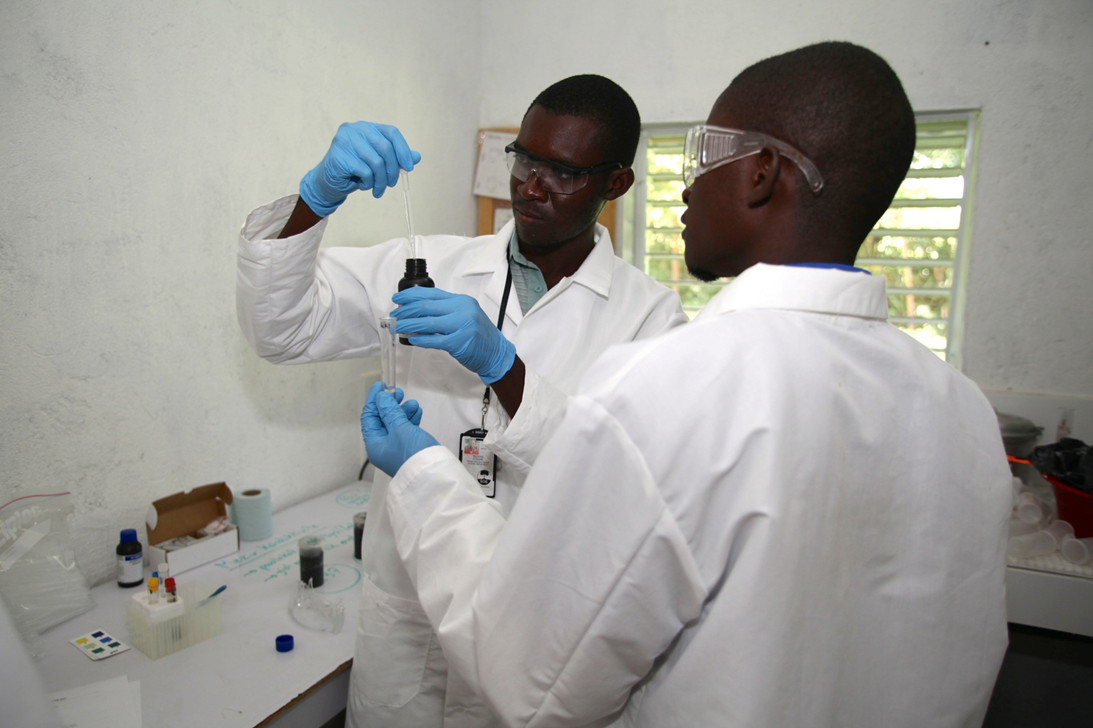
SOIL staff members working in the lab in Cap-Haïtien in 2013 test for indicator pathogens in the compost to ensure it has been fully and safely transformed into an agricultural grade soil amendment. Photo: Vic Hinterlang, courtesy of SOIL, all rights reserved.
SOIL on the ground
In the Fort Saint Michel area on the morning after the heavy rains, the benefits of SOIL’s system for customers were clear. One of the full buckets was set out by a household that consisted of a teenage student, Lovencie Pierre, and her mother, who works in one of the country’s ubiquitous lottery stores.
When Pierre and her mother realised rain was coming, they had simply picked up their cheerfully painted white-and-green toilet – made out of a light cement-based plaster applied over metal mesh – and moved it from an outdoor spot that might flood to an unfinished indoor room, where it now sat between a rusty folding cot and a big old refrigerator. Sometimes this room would also flood, Pierre said, in which case they would have to raise the toilet to a higher level. Citywide power and piped water outages didn’t affect the SOIL toilet’s operation, as they would a flush toilet.
In a courtyard outside was the remains of their old pit toilet. It had filled up, Pierre explained, so they had it emptied, but that process involved demolishing the structure around it. They couldn’t afford the investment to build a new outhouse, so they simply stacked metal and wood on top of the open hole to close it up, and instead payed the monthly fees for the SOIL toilet.
Across the alley, after the November downpour, a neighbour’s outhouse was filled nearly to the rim with a watery mix. The square pit had no seat, just a broken piece of concrete to sit on, so flies could flit in and out, transferring faecal matter from the toilet to people’s food. It would be nice to have a SOIL toilet, the neighbour said, if her landlord would provide it.
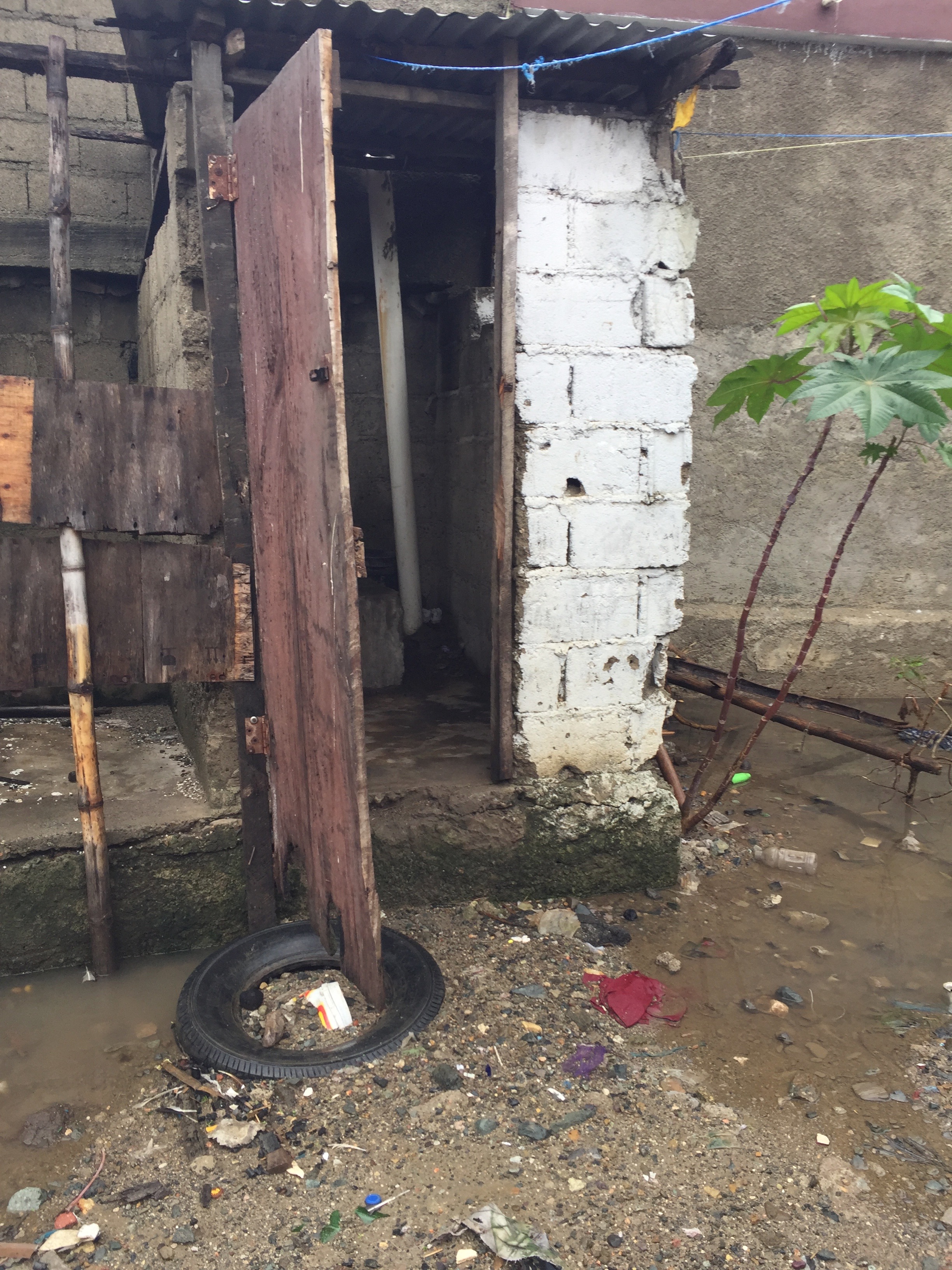
A pit latrine in regular use in Cap-Haïtien. Photo: Chelsea Wald (CC BY-NC-ND 4.0).
The whole community is vulnerable to sanitation-related diseases, as long as even a few people use pit latrines like these. But getting everyone to switch to SOIL buckets presents big challenges. Some are logistical: how to increase the efficiency of pickups, especially as they expand to 8,000 customers? How to keep service going if the roads are not just flooded but totally impassable? In November, EkoLakay had to stop operations for a few days during political protests. During recent protests, the team has used its deep local knowledge to continue to provide service, even as schools have been closed, roads blocked, and stores boarded up.
Most of Kramer’s challenges, however, are financial. Among them, how to help customers afford the service.
EkoLakay runs as a business, part of a cohort of new sanitation initiatives that do so, with the thought that they would be more financially sustainable than those that rely solely on public or aid funding. For the toilet rental and weekly pickups, customers pay between 200 and 350 Haitian gourde (about £1.85 to £3.25) per month. It’s priced for a country where, according to 2012 estimates, about 60% of the population lives below the national poverty line, but many still find it unaffordable. Kramer hopes to reach them by arranging for payments from landlords or even relatives abroad.
Another problem is that electronic money transfers by mobile phone or other means aren’t popular, and door-to-door collection of such small fees is prohibitively expensive. “So we actually have to first convince people that they should use mobile money as well as convincing them that they should have a toilet and pay for a toilet. So it’s like a whole stack of behaviour changes.” And, if customers fail to pay, workers come to take away the toilets – an unfortunate outcome that they try to avoid by providing debt-reduction plans to customers behind on their bills, Kramer says.
The other revenue stream, compost sales, has also been troubled. It’s not the quality – a small greenhouse study found that just one hit of SOIL’s compost improved a depleted soil for longer than some other types of fertilisers – but the price. SOIL has to price its product to compete with other local producers who make something “which is vaguely compost – it certainly has organic matter in it”, and have far lower operating costs since they aren’t working with hazardous materials, says Jonathan Greenham, the Chief of Party for a USAID-funded programme in Haiti called AVANSE that, among other things, is trying to convince smallholder farmers to apply compost. “To a group of farmers who don’t even think they should put compost on, arguing the nuances of 1% more nitrogen or whatever is not going to be a marketing ploy.”
Even with those two sources of revenue, SOIL faces a gap of about US$27 (£21) per household per month, currently covered by support from organisations including USAID, the IDB, and The 11th Hour Project, as well as thousands of individual donors. They will need a big new influx to fund their expansion, and then they will need to sustain the new size with reliable income. Since studies have shown that SOIL has climate benefits, including that its composting system has a smaller carbon footprint than the local treatment alternatives, carbon credits could someday provide a source of revenue. The ultimate goal, however, would be to access public financing, just like any public utility.
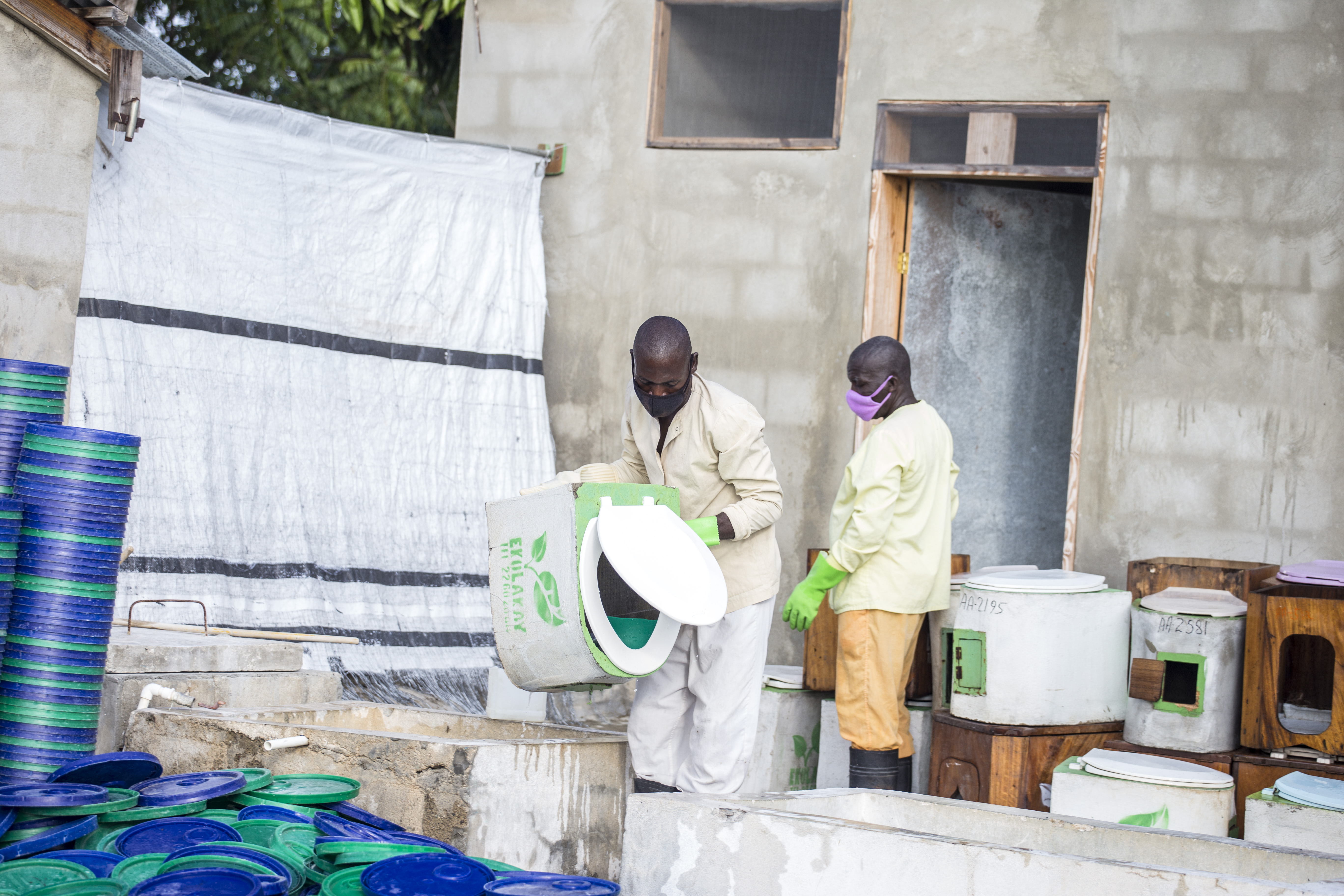
Workers clean and sanitize used toilets and the buckets that go in them. Photo: Caleb Alcénat/Labelimage for Project #WasteNot (CC BY-NC-ND 4.0).
Between 2006 and 2015, Haiti’s government contributed only 1% of the total funding for the water and sanitation sector; the rest came from donors. That could increase if, for example, Haiti included sanitation surcharges on water bills, an idea that Kramer promotes.
And Haitian officials have expressed enthusiasm for SOIL’s expansion: “SOIL is not just some pie-in-the-sky idea,” said Guito Edouard, the director general of DINEPA, Haiti’s water and sanitation authority, in a June meeting that brought together Cap-Haïtien’s sanitation players. “SOIL is here on the ground with us.”
In 2016, SOIL banded together with several similar projects that had independently started up in places that, like Haitian cities, have little in the way of sewerage, including Clean Team in Ghana, x-runner in Peru, Sanivation and Sanergy in Kenya, and Loowat in Madagascar. Under the banner of the Container-Based Sanitation Alliance (which avoids the negative connotations of “bucket”), they have released white papers and planned conference sessions to make their case. This month at a conference in South Africa, the World Bank released a study on container-based sanitation, including a case study of SOIL.
See all references
Not long ago “we were just seen as very small players doing something new and potentially wacky,” Kramer says. But now, as this upstart idea finds its foothold amidst Haiti’s formidable challenges, SOIL is helping people worldwide think outside the sewer.

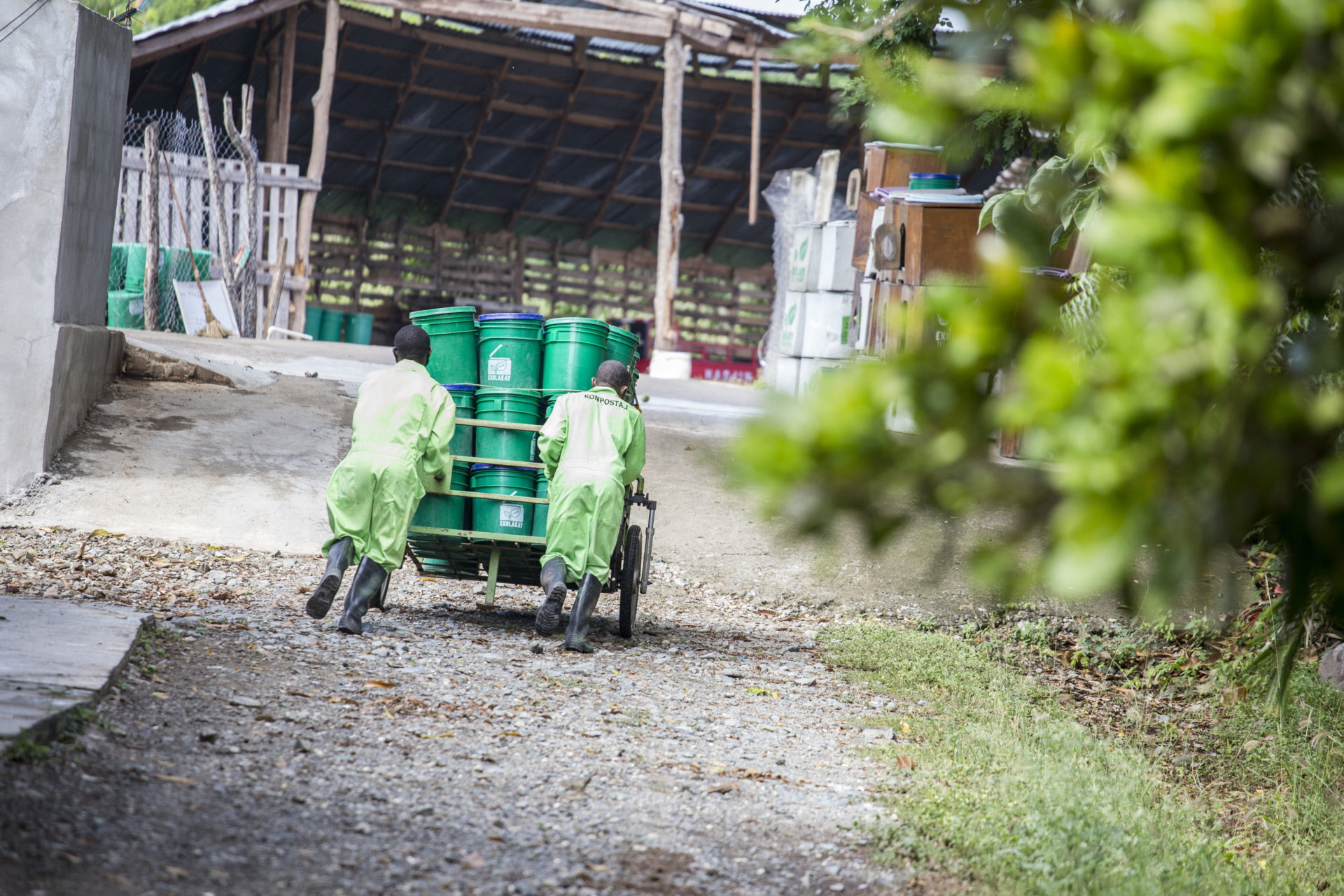
 19 MIN READ / 3544 WORDS
19 MIN READ / 3544 WORDS
